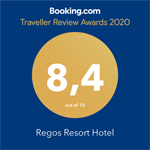Olympiada is a refugee village built after 1922, but only a kilometre east of the village is the site of the ancient city of Stagira; probably the most important historical site in Halkidiki. During the 7th century B.C. Stagira was colonized first by Andrians and then, later, by Chalceans.
The city was taken over by the Persians in the Persian Wars and became a member of the Athenium Alliance. Later in 424 B.C. the city rebelled and joined the Lacedaemonians, causing it to be beseiged by the Athenians without success. Stagira later became a member of the Chalcidean League, until it was destroyed in 348 B.C. by Philip; who later rebuilt it in order to honour Artistotle.
This short but interesting walk takes one through the archeological remains of the Ancient City of Stagira, which was situated on the two small hills, overlooking the sea, at the north western corner of Olympiada. It then ascends the hill to the south of the
town on a forest track providing a fine woodland walk, with the added bonus of panoramic views over Olympiada and its bay below. A quick descent to the village then follows on a narrow, hunters' path, and the walk ends with a stroll along the beach.
The start for this walk is about 100m north of the Portes Palace Hotel in Potidea. A road leads down to the beach in about 400m. On reaching the beach road turn right for about 100m and then left across the dunes to meet a sandy track. turn left onto this track and follow it northwards until you see the lake on your left. The size of the lake varies according to the season. Look for a track to the left which takes you nearer to the lake and follow this track northwards with reeds and the lake on your left.
A great variety of water birds can be seen, depending on the time of year. For example, waders are often present in great numbers such as black winged Stilts and Avocets. Caspian gulls, coots and Teal ducks are also plentiful.
IOccasionally present are Squacco Herons, Mallards, Widgeons and Shoveler ducks. On rare occasions one can see Greylag Geese, Great White Egrets, Whooper Swans, Mute Swans and Shelducks.
Continue parallel to the lake keeping to the path closest to the water which is dry underfoot. This may vary with the season. every now and again a sandy track will lead off to your right away from the lakes. Any of these will take you across to the beach and the waters of the Toroneos Gulf. You can return along the track parallel to the beach or by retracing your steps if you want to see the wildlife on the lake.





